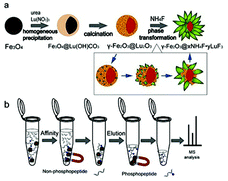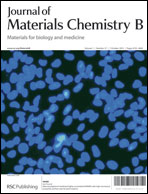Novel 3D flowerlike hierarchical γ-Fe2O3@xNH4F·yLuF3 core–shell microspheres tailor-made by a phase transformation process for the capture of phosphopeptides†
Abstract
Novel three-dimensional (3D) flowerlike hierarchical γ-Fe2O3@xNH4F·yLuF3 core–shell architectures were synthesized by a simple phase transformation route under mild conditions. The evolution of the flowerlike structure assembled by thin xNH4F·yLuF3 nanosheets has been investigated in detail. We found that an appropriate amount of NH4F and a suitable phase transformation reaction temperature are crucial for the formation of the flowerlike structure, while the calcination treatment is essential to maintain the well-defined core–shell structure. A possible formation mechanism was proposed for the phase transformation reaction and the self-assembly growth in situ. The novel composite material with large open pores, a specific surface area (26.2 m2 g−1), strong reversible magnetic response (Ms = 27.99 emu g−1), and good structural stability has been primarily applied for the selective and effective capture of phosphopeptides and it showed good performance. The obtained products may also have potential applications in areas such as water treatment, purification of biomolecules, and solid catalysis.


 Please wait while we load your content...
Please wait while we load your content...